

Part I- Basic Principles in Salt Tectonics
3.11- Autochthonous and Allochthonous Salt
Goguel (1983) with an ingenious experience (fig. 101) showed the more likely evolution of an unstable salt layer with time. It suggested how an autochthonous salt layer (mother salt layer) can generate allochthonous salt layer, as in fig. 100.

Fig. 100- On this tentative interpretation of a line deep water seismic line of Gulf of Mexico, autochthonous salt, that is to say, salt resting on the original strata on which it accumulated and allochthonous salt, i.e., salt emplaced at stratigraphic levels above the autochthonous ) are easily recognized. Obviously, the allochthonous salt is the result of the upward displacement of the autochthonous salt.
Goguel, in his experiment, using an aquarium, superposed two liquids with different density, to simulate a mother salt layer and an overburden:
(i) At the bottom, he poured oil (the lighter liquid), and (ii) At the top, he poured water, the denser liquid.

Such a situation, i.e. a lighter fluid under a denser one is an unstable situation. Thereby, with time, the lighter fluid will become to surface, while the denser goes to the bottom. During such an inversion, several steps or stages can be considered:
a) Small Positive Anomalies: at the oil-water interface small equidistant (Rayleigh-Taylor instability) anomalies develop (1 in fig.101).
b) Mound Stage: the anomalies grow-up forming mounds characterized by its relatively flat flanks (2).
c) Dome Stage: growing, the mounds become domes. Their flanks reach a quite high dip, near the vertical (3).
d) Post-Dome Stage: since a dome arrives at surface, the oil starts to flow laterally, creating post-dome structures; some of these structures become disconnected from the mother oil layer (4 and 5).
e) Canopy Stage: at surface, the oil flowing in opposite direction creates canopy structures similar to those created by ascendant convection currents (5 ).
f) Stable Stage: Finally, all oil will be transferred at surface, reaching an equilibrium state (6).
The last three steps simulate the development of allochthonous salt layers, which can be connected or disconnected with the mother salt layer.
3.11.2- M. Jackson’s Experience
Using a centrifuge, M. Jackson (1986) simulated the different steps of salt diapirism and the formation of the allochthonous salt nappes of the Gulf of Mexico (fig. 102).
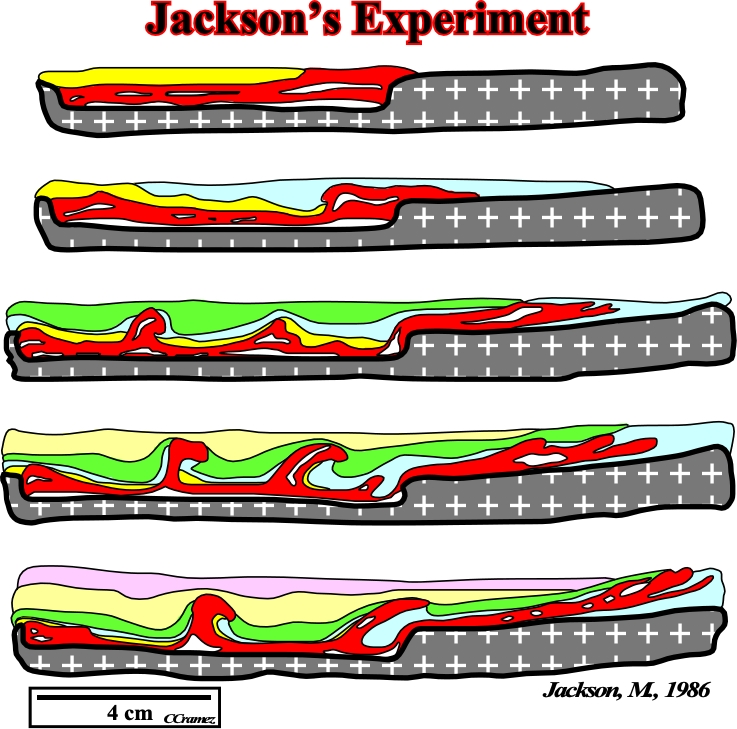
In this simulation, where several stages (fig. 103) can be considered, one must take into account:
1) The presence of an important step on the infrastructure ;
2) The red layer simulates the salt ;
3) The red layer flows laterally and vertically due to the loading of the yellow layer ;
4) The extension of the yellow layer does not exceed that of the black layer ;
5) The extension of the blue layer, exceeds that of the red layer ;
6) The loading of the blue layer obliges the red layer to flow vertically and slightly rightward ;
7) The depocenters of the green layer not only force the red marker to form intrusive domes, but intrusive nappes as well. They are clearly intruded and cut the blue layer.
8) The diapiric mechanism and the allochthony of the red layer continue with the deposition of the upper layers.The final result is quite similar to that that geologists deducted from the tentative geological interpretation of the regional lines whether:
(i) In Gulf of Mexico (fig. 103) or (ii) In offshore Angola (fig. 104).
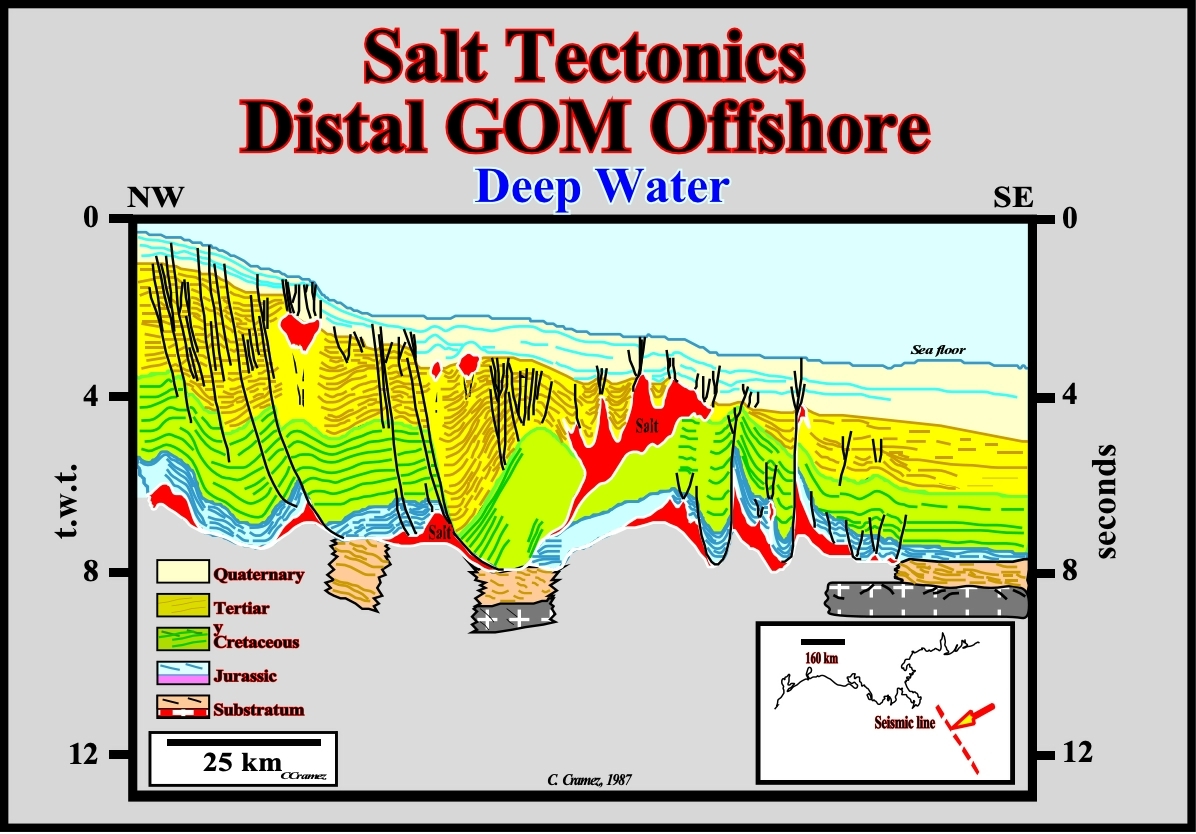
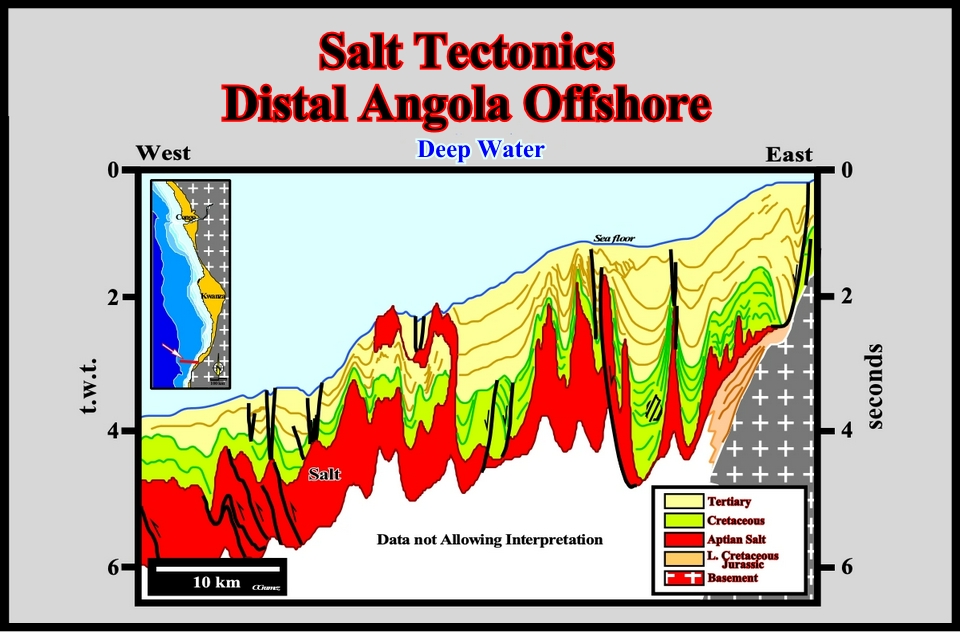
Iran is exceptionally rich in evaporite deposits. They were deposited episodically throughout the Phanerozoic. The best known evaporites are the Infra-Cambrian Hormuz salts (800 to 500 Ma) of the southern Zagros and Persian Gulf region and their equivalents in Central Iran, the Permo-Triassic anhydrites of the Gulf and Coastal Zagros, the Upper Jurassic evaporites in the Gulf region and eastern Central Iran, the Lower Fars (Miocene) salt of the Zagros, and the Tertiary salts of the Great Kavir basin in Central Iran (fig. 105), which has a unique abundance of exposed salt diapirs.
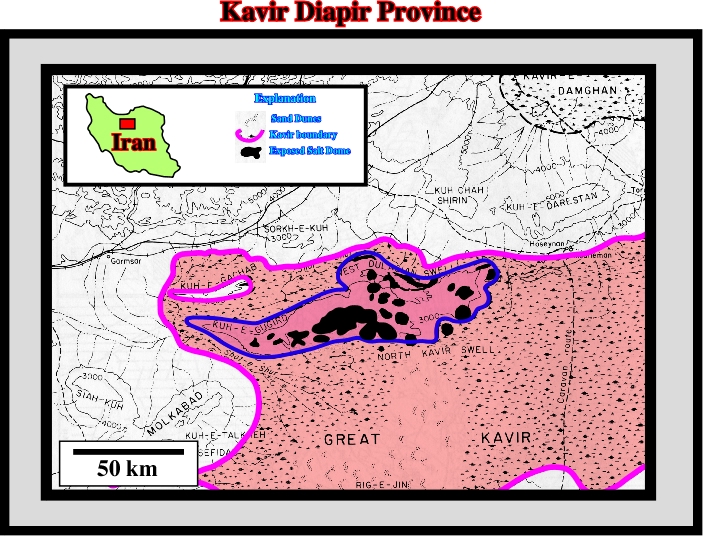
In 1992, M. Jackson, proposed few geological cross-sections of the exposed salt domes. In addition, adopting critical scientific approach, he hypothesized two different possible, and opposite, geological evolutions for the Kavir diapir province:
(i) Diapirism without Posterior Folding and (ii) Folding followed by Diapirism.
These opposite hypotheses that will be described here after are quite interesting. Indeed, in the majority of the salt basins, geologists must always decide whether the salt structures were just induced by halokinesis (no tectonic stress σt) or by salt tectonics (with a tectonic stress σt), that is to say, if an extensional, or compressional, tectonic regime is also responsible by the final result. Actually, in these notes, this problem will be tackle several times (offshore Angola, Gulf of Mexico, North Sea, etc.). The petroleum exploration implications are quite different.
(i) Diapirism without Posterior Folding
On this hypothesis (fig. 106), M. Jackson proposed:
a) Around 35 Ma (35 Ma means 35 million years ago, i.e., a geological age while 35 My means an interval whether Cretaceous or Paleozoic of 35 million years), the older salt (in black) was deposited in Alpine synclines.
b) After the deposition of the young salt (in yellow), mound structures rise within the growth synclines.
c) At 10 Ma, domes structures are predominant.
d) Around 5 Ma, late diapirism creates canopies and thrusting.
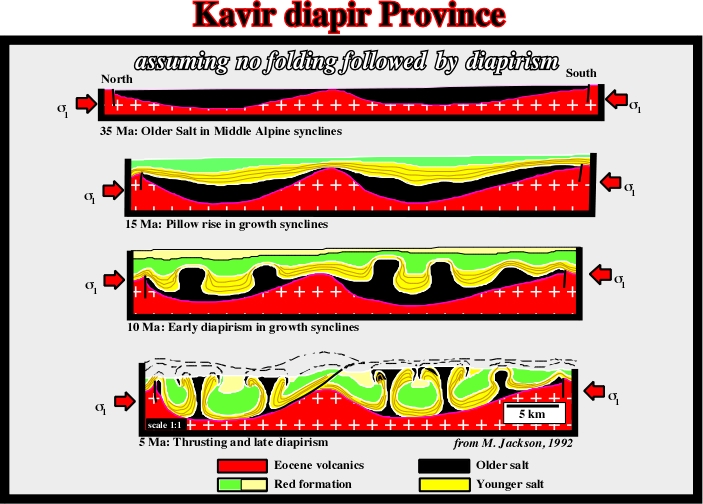
(ii) Folding followed by Diapirism
The alternative hypothesis (fig. 107) implies a shortening and folding after diapirism in order to explain the formation of salt canopies. It can be summarized as follows:
a) At around 35 Ma, an extensional tectonic regime creates rift-type basins, which were filled by older salt (black).
b) At the Upper Miocene, first in the southern rift-type basin, and then in the northern basin, the older salt started to move during the deposition of the younger salt. Mounds and domes were developed.
c) During the Pliocene, a compressional tectonic regime took place and shortened the rift-type basins:
- The Oligocene normal-faults, which have created the rift-type basins, were reactivated as reverse faults inducing tectonic inversions.
- The salt layers as well as sediments were folded, what facilitate a late diapirism of the salt layers with development of canopy structures.
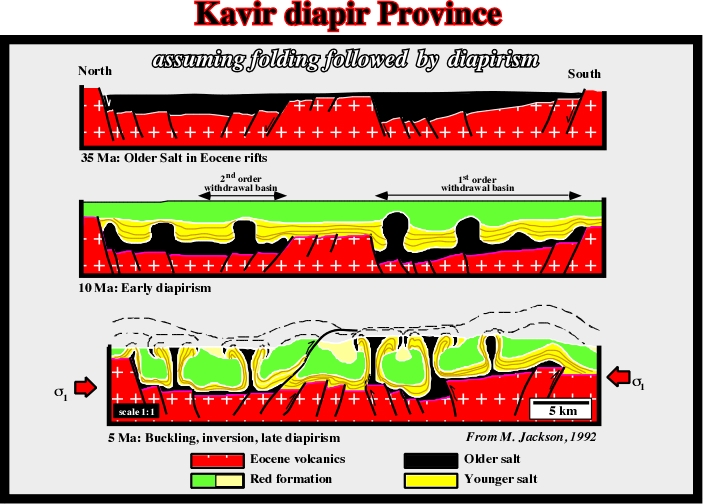
Contrary to autochthonous salt, where salt bodies rest more or less on the original strata or surface on which they accumulated, allochthonous salt comprises sheet-like salt bodies emplaced at stratigraphic levels above the autochthonous mother salt layer. As was suggested by several authors, the term allochthonous salt is applied even if the salt sheet remains attached to its source layer. M. Jackson (1991) evoked two main reasons for this liberal definition:
I- Allochthonous salt is transported from its original position and rests on a different substratum regardless of whether its roots remain attached.
II- Determining whether a salt sheet is detached or connected by only a thin stem is, generally, impracticable even with modern seismic data.
Therefore, the terminology for allochthonous salt structures (fig. 108) cannot be definitive. Several overlapping terms are currently in use. The terminology proposed by the Sub-commission on Tectonic Nomenclature (International Union of Geological Sciences) is illustrated in fig. 108. It will be followed in these notes.
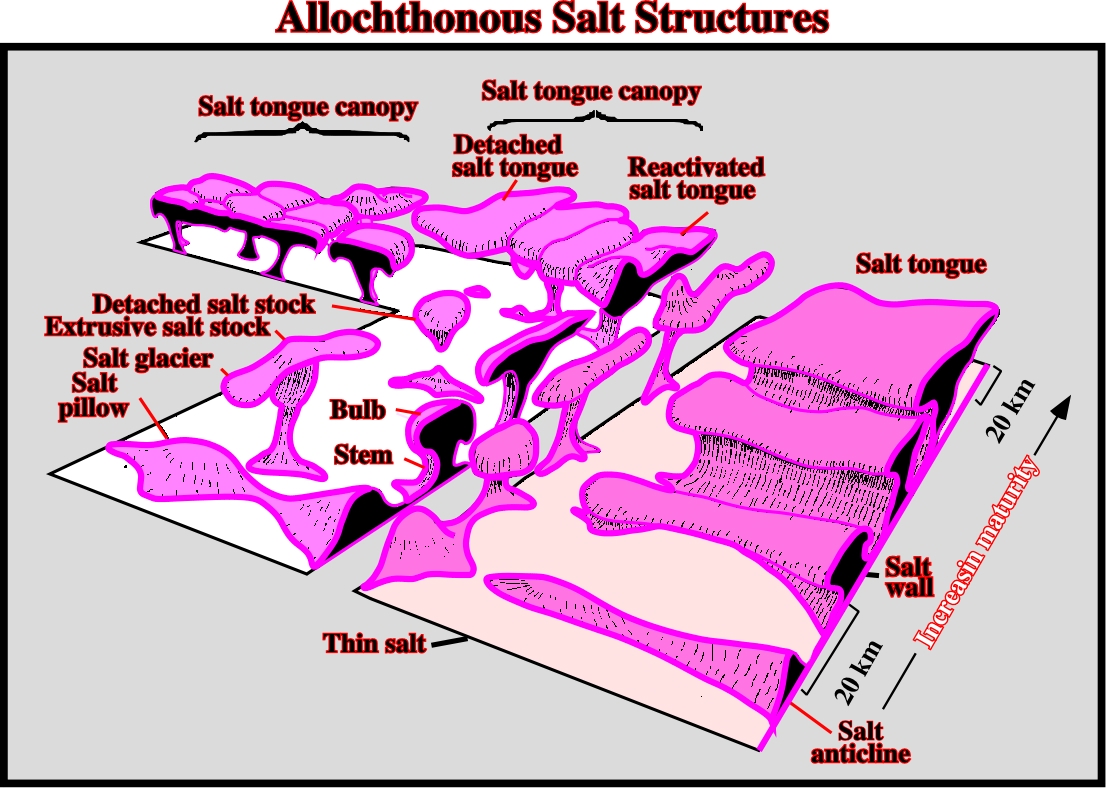
Fig. 108- Block diagram showing the majority of the allochthonous salt structures. The structural maturity and size increases toward the composite, coalesced structures in the background. A salt wall is an elongated up-welling of diapiric salt, commonly forming sinuous, parallel rows. A salt sheet is an allochthonous salt whose breadth is at least 5 times its maximum thickness. A salt laccolith is an intrusive salt sheet whose ratio of maximum width to maximum thickness is between 5 and 20. A stem is the comparatively slender part of a salt diapir below the bulb. A salt anticline is a compressional bell-shaped structure with a core of salt. A salt tongue is a highly asymmetric variety of salt sheet or salt laccolith fed by a single stem. A bulb is the overhanging, swollen crestal portion of a salt diapir. A salt pillow is a sub-circular up-welling of salt with concordant overburden. A salt glacier is a sheet-like extrusion of salt issuing from an exposed diapir and spreading beneath air or water. A salt stock is a plug-like salt diapir with sub-circular plan-form. A salt tongue canopy is a coalescence of salt tongues. A detached salt stock is a plug-like salt diapir with sub-circular plan-form detached from the mother salt layer.
A salt sheet is a broad, non-genetic term that can be defined as any allochthonous salt structure whose breadth is several times greater than its maximum thickness. Therefore, it can include salt tongues, salt laccoliths and salt sills (fig.109 & 110).
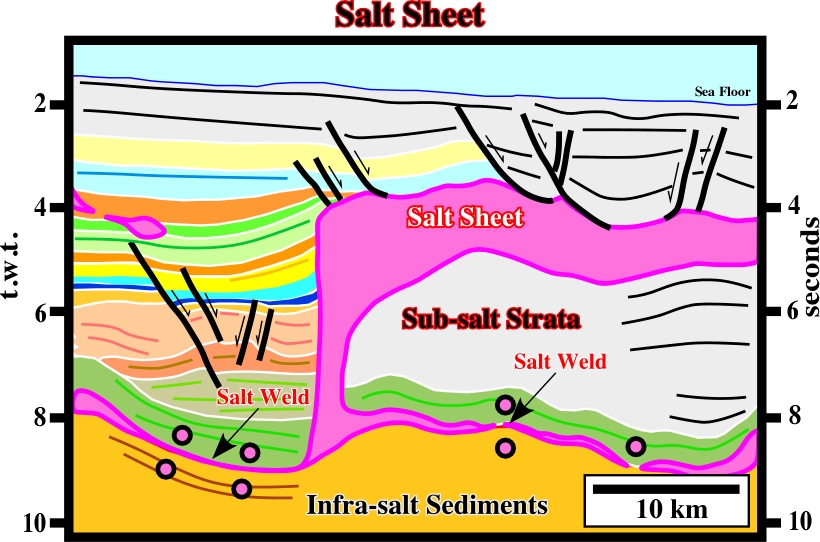
Fig. 109- On this tentative geological interpretation of a GOM seismic line, the his single rooted allochthonous salt structure can be considered a salt sheet over which sedimentary lengthening is highlighted by a normal faulting system. Several salt welds can be recognized along the salt induced tectonic disharmony.
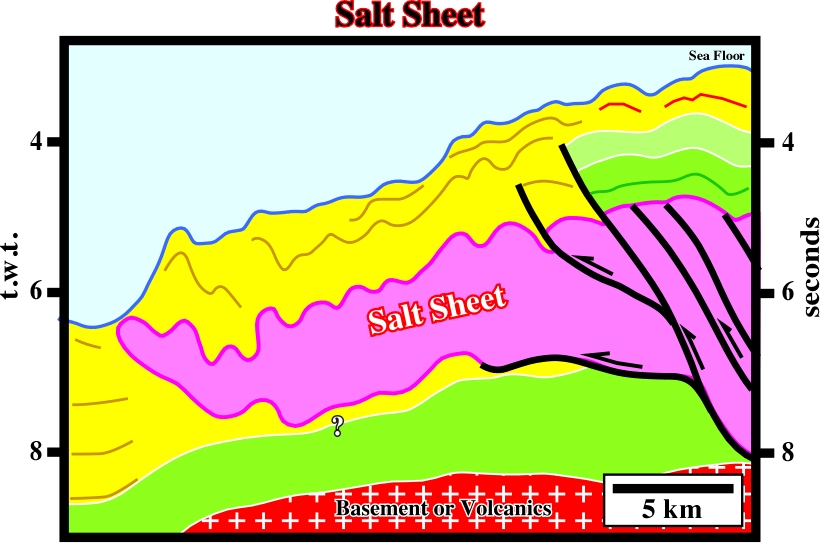
Fig. 110- On this tentative interpretation of a distal Angola offshore seismic line, a reactivated salt sheet (shortened), located westward of the original salt limit deposition, can be proposed. On the right end of the seismic line, the high thickness of the salt is, obviously, due to thrusting. On the other hand, a depth conversion of this line, plainly, indicate that the western depositional limit of the salt prevented the seaward gliding of salt (following the up-dip salt extension) the inducing an imbrication of salt thrusts.
A salt laccolith is an intrusive salt sheet that has a ratio of maximum width to maximum thickness, arbitrarily, less than 20. Its upper contact is typically concordant, whereas its lower one is, commonly, slightly discordant (fig. 111 & 112).

Fig. 111- On this tentative interpretation of seismic line of Gulf of Mexico, taking into account the geometry and dimensions, this allochthonous salt structure can be considered a salt laccolith, which emplacement seems to have deformed the sea floor . The ramp of the salt laccolith, i.e., the feeder is just partially visible. It corresponds to a growth-fault, induced by salt evacuation, looking landward (counter-regional fault system). The salt induced tectonic disharmony at the autochthonous salt level is easily recognized.
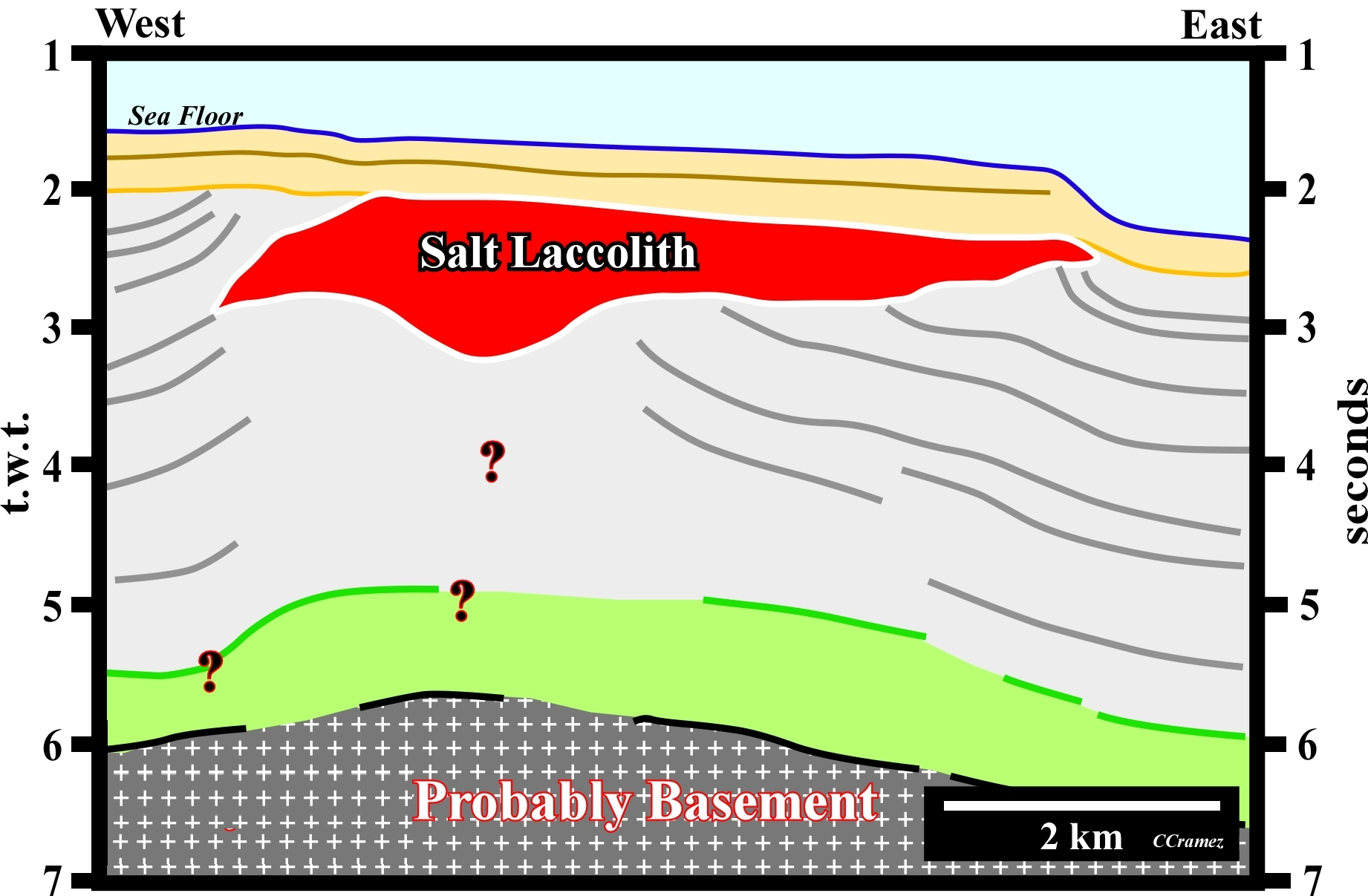
A salt sill is an intrusive salt sheet that has a ratio of maximum width to a maximum thickness (arbitrarily) more than 20. It is typically intruded at depths of only a few hundred meters or less. Contact relations are similar to those of a salt laccolith (fig. 113 & 114).
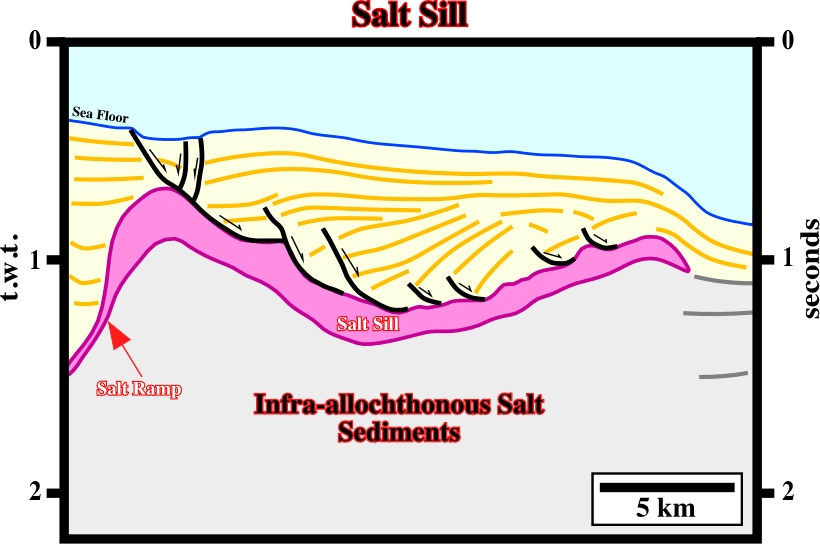
Fig. 113- In spite of a late reactivation, this single rooted allochthonous salt structure can be considered a salt sill. The ratio of width/thickness (in depth) is probably higher than 20. Notice that above the salt sill the sediments are contemporaneous of the late salt reactivation, which controls the morphology of the sea floor.
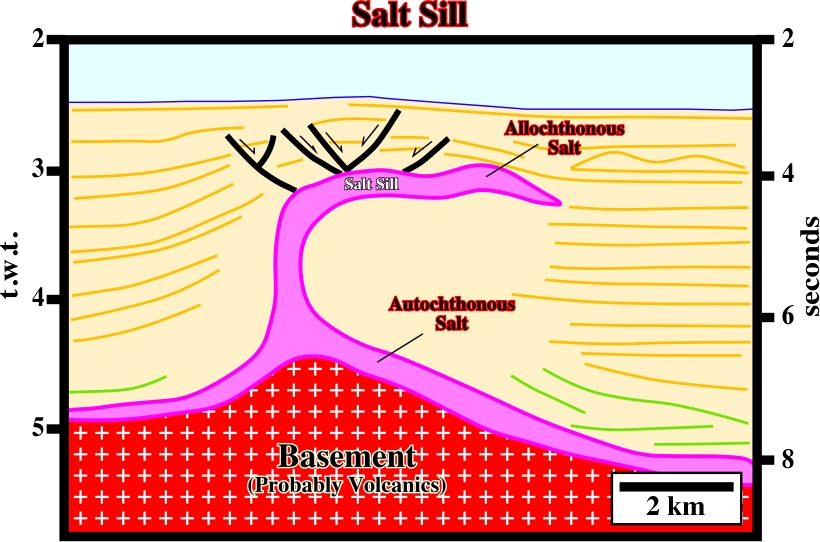
A salt tongue is a highly asymmetric variety of salt sheet or salt laccolith fed by a single stem. Individual salt tongues are as much as 80 km long and 7 km thick. This term is typically applied to wedge-like bodies having tapered angles and do not resemble a salt still (fig. 115 & 116).
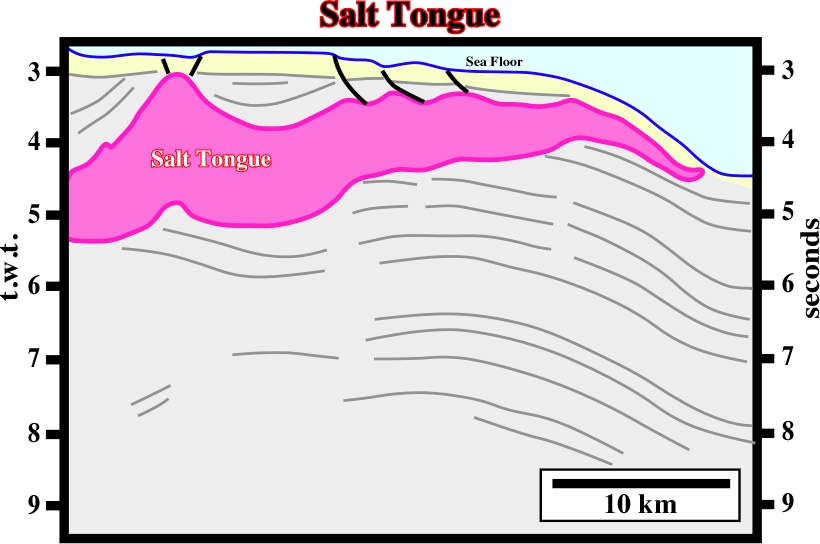
Fig. 115- Taking into account the length and the thickness, this GOM allochthonous salt structure can be considered a salt tongue. In fact is more than 30 km long and its thickness reaches around 2km, in spite of the fact that it decreases progressively seaward. Its emplacement seems be quite recent and it strongly deforms the sea floor.
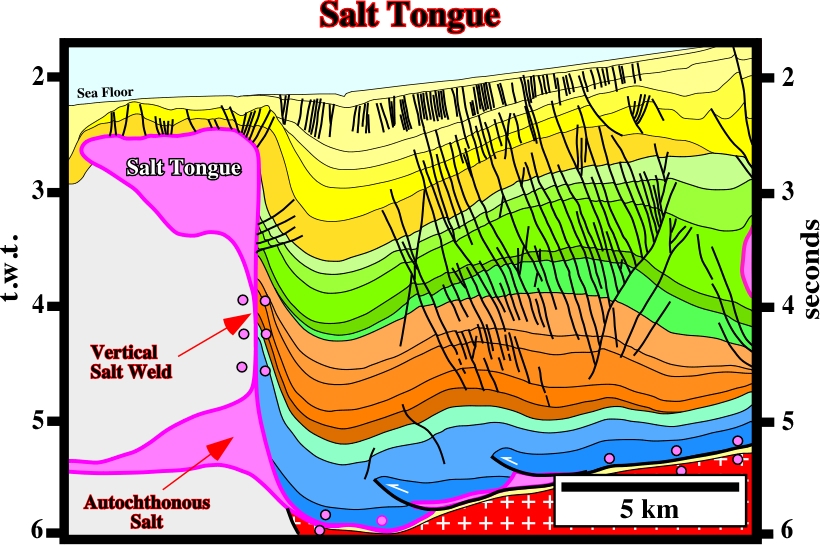
Fig. 116- In deep offshore Angola, salt tongues are frequent, as illustrated by this tentative interpretation. The majority of them were shortened by a late compressional tectonic regime, probably, associated with ridges-push mechanism. The stem between the allochthonous and autochthonous salt is, often, be reduced to a vertical salt weld as it is the case on this tentative. A lot of morphological traps by juxtaposition are associated with the inter-domal antiform structures that can be considered as late turtle-back structures.
A secondary-cycle diapir is a diapir that rises by reactivation of allochthonous salt (fig. 117 and 119).

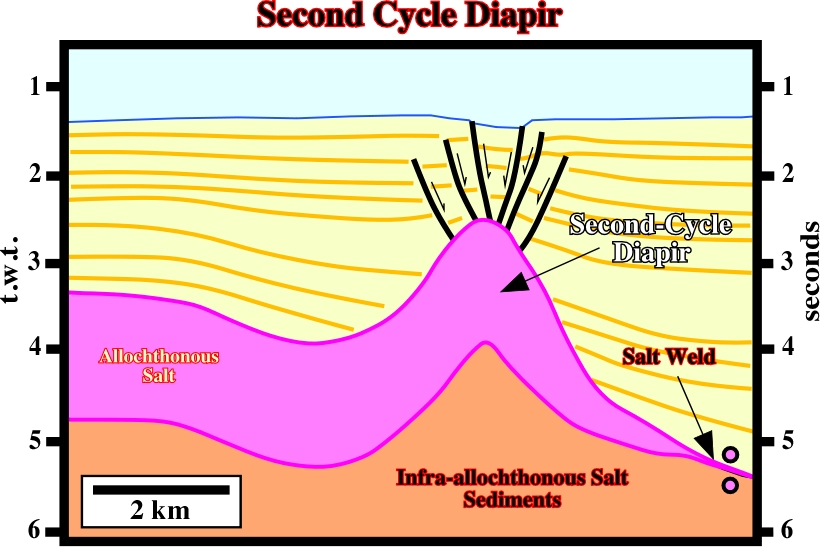
Fig. 118- Along of the allochthonous salt sheet, a second-cycle diapir is, clearly, recognized on this tentative interpretation of a seismic line of the Gulf of Mexico. Taking into account the salt weld and the pull-up of the bottom of the allochthonous salt, which corresponds to a seismic pitfall, the upward movement of this second-cycle diapir extended the overlain sediments. The normal faults developed at the apex of the diapir, accommodate the sediments to the volume problem created by the sedimentary lengthening.
A third-cycle diapir is that which rises from salt sheets derived from still older salt sheets that have also been inferred in the basin (Fig. 119 & 120).
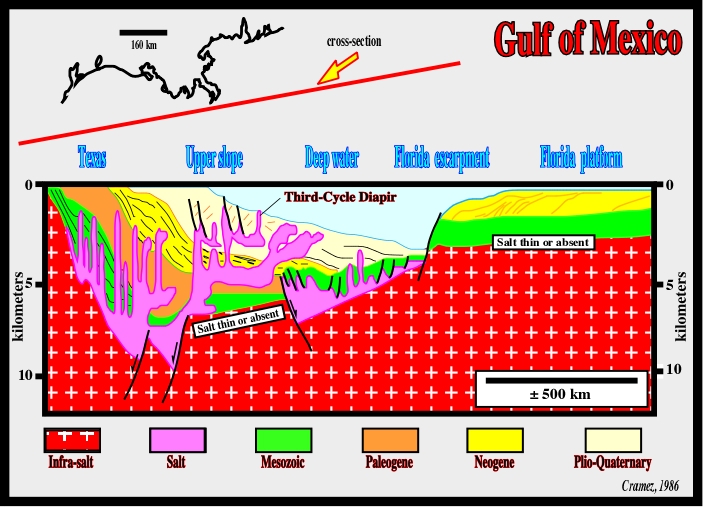
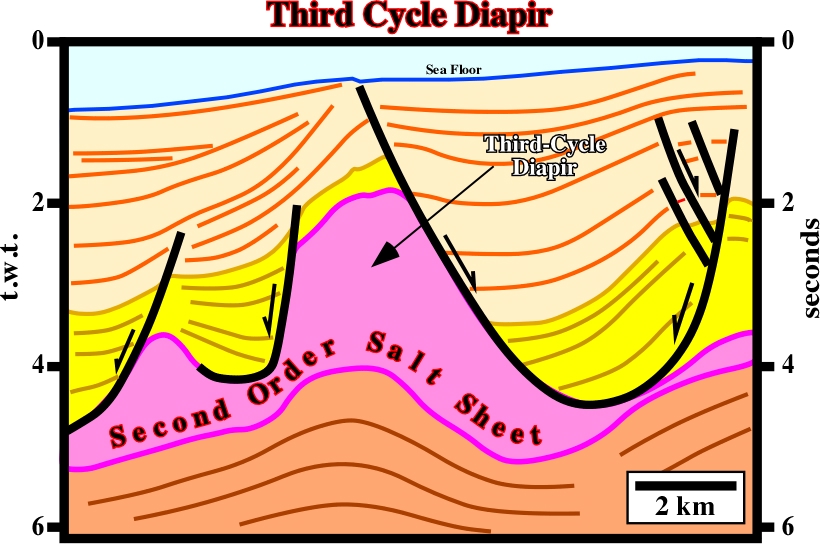
Fig. 120- On this tentative interpretation of GOM seismic line, the salt structure on a second order salt sheet, rising form a rising from allochthonous salt (derived from a still older salt sheet)can be been interpreted as a third-cycle diapir. The sediments above the second order salt sheet seem to have been deposited during the salt movement of the salt sheet, as suggested by the internal configuration of the reflector of the upper seismic intervals.
A salt canopy is a composite diapiric structure formed by partial or complete coalescence of diapir bulbs or salt sheets. These bodies coalesce along salt sutures and may or may not, be connected to their source layer by feeder stems (fig. 121 & 122).
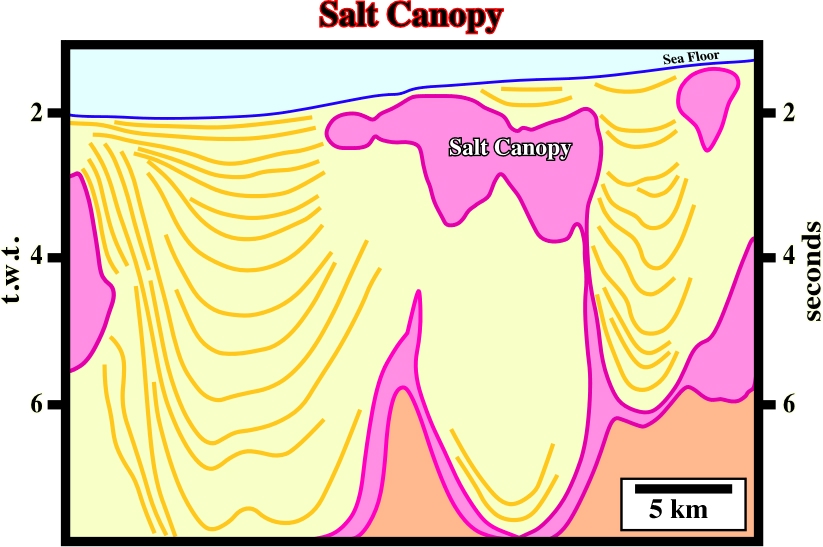
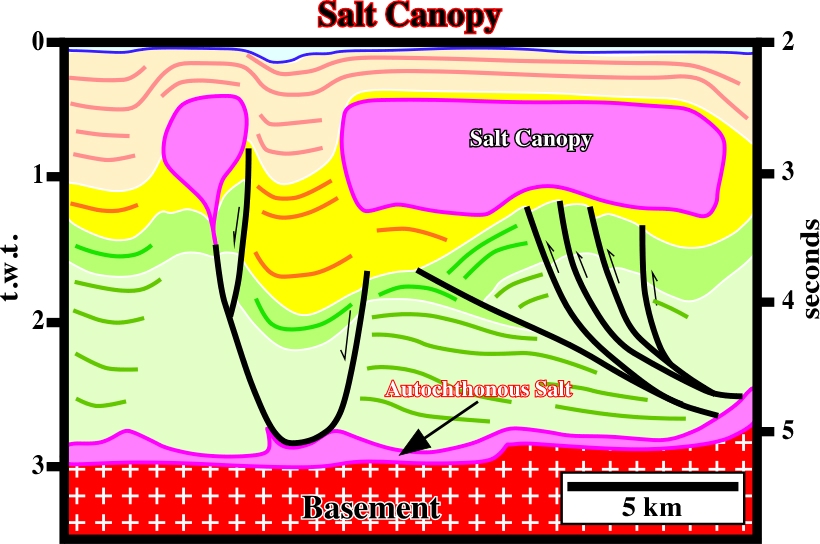
A salt-stock canopy is a salt canopy, which forms by coalescence of stocks, that is to say, of plug-like salt diapirs having sub-circular plan-form (fig.123 & 124).
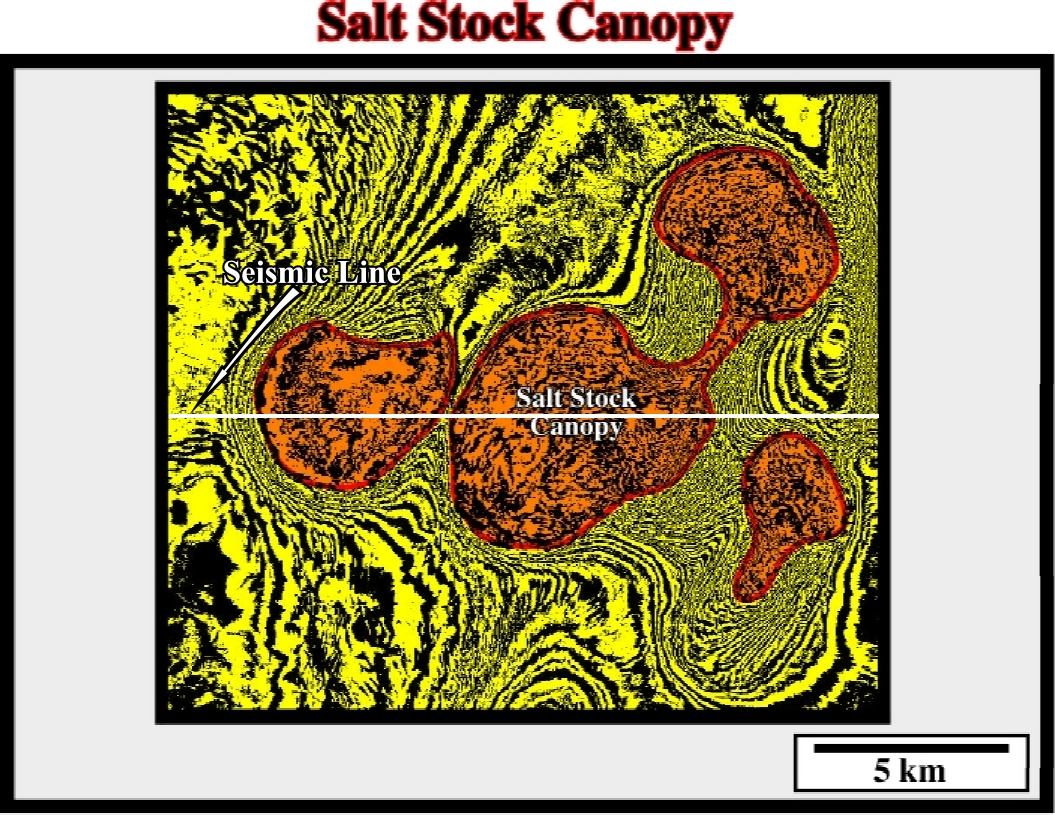
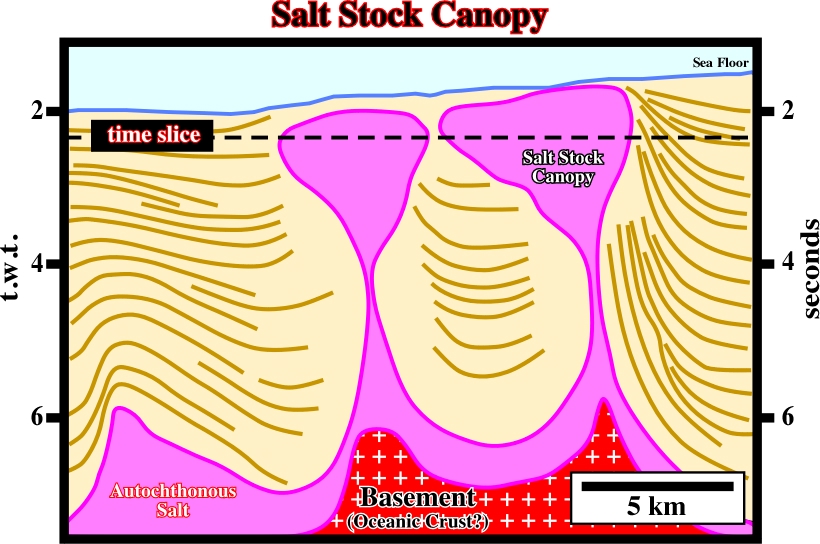
A salt-wall canopy is a salt canopy that forms by coalescence of salt walls (fig. 125 & 126).
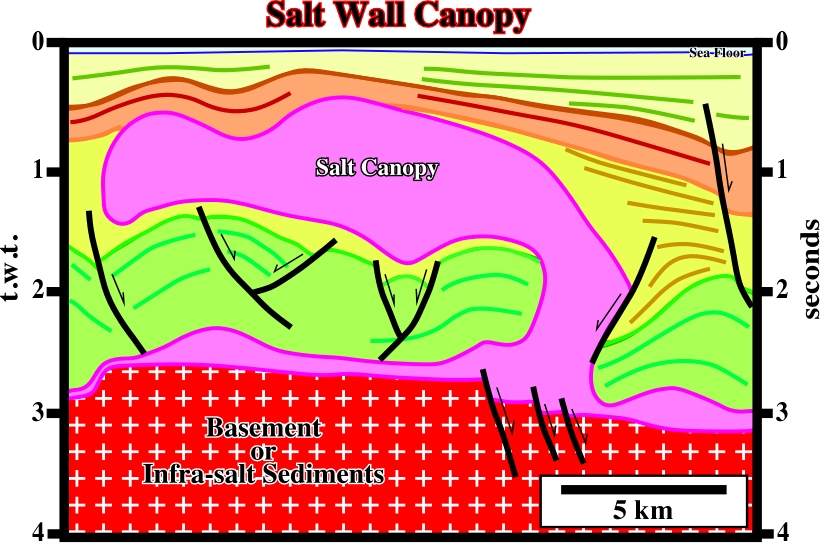
A salt-tongue canopy is a salt canopy that forms by coalescence of tongues.

A salt suture is a junction between individual salt structures that have coalesced, laterally, to form a salt canopy. Incomplete sutures have lensoid depression of overburden along them. Complete sutures have folds in the overburden above them. A salt suture is below a subsided, cuspate synforms, or it is the junction of a pair of oppressed, raised salt antiforms. (fig. 127 & 128).

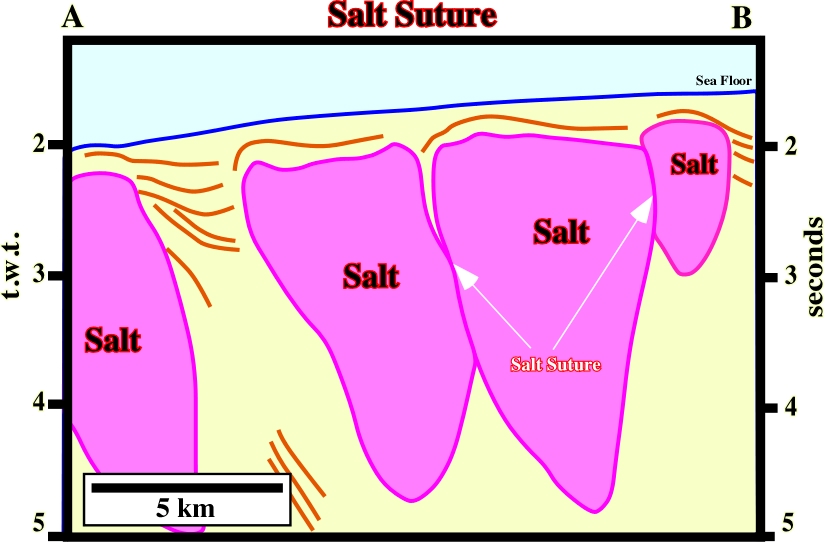
A salt glacier, or namakier, is a sheet-like extrusion of salt flowing from an exposed diapir and spreading beneath air or water (fig. 129 & 130).
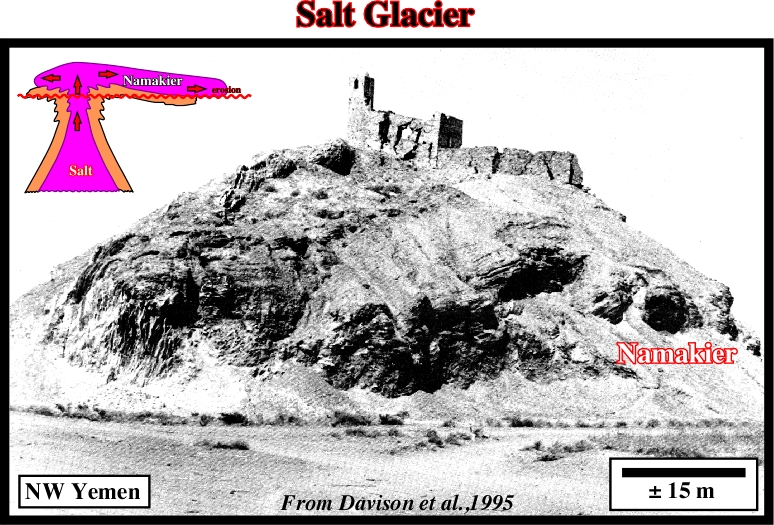
Fig. 130- In Angola deep water Angola, the evidence of salt glaciers is corroborated by this tentative geological interpretation, in which an allochthonous salt tongue, with an associated salt glacier, strongly, deform the sea floor. Such a deformation was enhanced by a local compressional tectonic regime, which squeezes the diapir, creating not only an important scarp, but thrust faults on extrusive salt. Actually, it is likely that when the salt became extrusive, it flowed, laterally, along the sea floor, as a glacier, before being squeezed.
to continue press
next